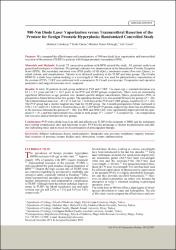| dc.contributor.author | Çetinkaya, Mehmet | |
| dc.contributor.author | Önem, Kadir | |
| dc.contributor.author | Rifaioğlu, Mehmet Murat | |
| dc.contributor.author | Yalçın, Veli | |
| dc.date.accessioned | 2020-11-20T15:04:49Z | |
| dc.date.available | 2020-11-20T15:04:49Z | |
| dc.date.issued | 2015 | |
| dc.identifier.issn | 1735-1308 | |
| dc.identifier.issn | 1735-546X | |
| dc.identifier.uri | https://hdl.handle.net/20.500.12809/2934 | |
| dc.description | WOS: 000366345600010 | en_US |
| dc.description | PubMed ID: 26571321 | en_US |
| dc.description.abstract | Purpose: We compared the effectiveness and complications of 980-nm diode laser vaporization and transurethral resection of the prostate (TURP) in patients with benign prostatic hyperplasia (BPH). Materials and Methods: In total, 72 consecutive patients with BPH entered the study. All patients underwent general and urological evaluations. The primary outcome was improvement in the International Prostate Symptom Score (IPSS). The secondary outcomes were IPSS quality of life (QoL), maximum urinary flow rate (Qmax), residual volume, and complications. Patients were allocated randomly to the TURP and laser groups. The Ceralas HPD120, a diode laser system emitting at a wavelength of 980 nm, was used for photoselective vaporization of the prostate (PVP). TURP was performed with a monopolar 26 French resectoscope. Preoperative and operative parameters and surgical outcomes were compared. Results: In total, 36 patients in each group underwent PVP and TURP. The mean age standard deviation was 63.1 +/- 9.1 years and 64.7 +/- 10.2 years in the PVP and TURP groups, respectively. There were no statistically significant differences in age, prostate size, prostate-specific antigen concentration, Qmax, preoperative IPSS, or preoperative Qmax between the two groups. The operation duration was also similar between the groups (P =.36). The catheterization time was 1.45 +/- 0.75 and 2.63 +/- 0.49 days in the PVP and TURP groups, respectively (P <.01). The PVP group had a shorter hospital stay than the TURP group. The 3-month postoperative Qmax increased to 9.90 +/- 3.61 and 6.59 +/- 6.06 mL/s from baseline in the TURP and PVP groups, respectively; there was no difference in the increases between the groups (P =.08). The IPSS and IPSS-QoL were significantly improved with the operation (P <.01), and this improvement was similar in both groups P=.3 and P=.8, respectively. The complication rate was also similar between the two groups. Conclusions: PVP with a diode laser is as safe and effective as TURP in the treatment of BPH, and the techniques have similar complication rates and functional results. PVP has the advantage of shorter hospitalization and catheter indwelling times and no need for discontinuation of anticoagulant therapy. | en_US |
| dc.item-language.iso | eng | en_US |
| dc.publisher | Urol & Nephrol Res Ctr-Unrc | en_US |
| dc.item-rights | info:eu-repo/semantics/openAccess | en_US |
| dc.subject | Ablation Techniques | en_US |
| dc.subject | Lasers | en_US |
| dc.subject | Semiconductor | en_US |
| dc.subject | Therapeutic Use | en_US |
| dc.subject | Prostatic Neoplasms | en_US |
| dc.subject | Surgery | en_US |
| dc.subject | Transurethral Resection of Prostate | en_US |
| dc.subject | Urinary Bladder Neck Obstruction | en_US |
| dc.subject | Urinary Catheterization | en_US |
| dc.title | 980-Nm Diode Laser Vaporization versus Transurethral Resection of the Prostate for Benign Prostatic Hyperplasia: Randomized Controlled Study | en_US |
| dc.item-type | article | en_US |
| dc.contributor.department | MÜ, Tıp Fakültesi, Cerrahi Tıp Bilimleri Bölümü | en_US |
| dc.contributor.institutionauthor | Çetinkaya, Mehmet | |
| dc.identifier.volume | 12 | en_US |
| dc.identifier.issue | 5 | en_US |
| dc.identifier.startpage | 2355 | en_US |
| dc.identifier.endpage | 2361 | en_US |
| dc.relation.journal | Urology Journal | en_US |
| dc.relation.publicationcategory | Makale - Uluslararası Hakemli Dergi - Kurum Öğretim Elemanı | en_US |


















